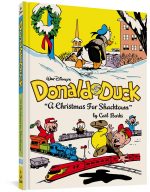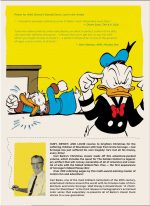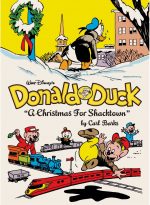


By Carl Barks & various (Fantagraphics Books)
ISBN: 978-1-60699-574-7 (HB/Digital edition)
Win’s Christmas Gift Recommendation: Utter Acme of All-Ages Entertainment… 10/10
Carl Barks was born in Merrill, Oregon in 1901, growing up in the rural areas of the West during some of the leanest times in American history. He tried his hand at many jobs before settling into the profession that chose him. His early life is well-documented elsewhere if you crave detail, but briefly, Barks worked as an animator at Disney’s studio before quitting in 1942 to work in the new-fangled field of comic books.
With studio partner Jack Hannah (another animator turned occasional strip illustrator) Barks adapted a Bob Karp script for a cartoon short into Donald Duck Finds Pirate Gold. It was published in October of that year as Dell Four Color Comics Series II #9 and – although not his first published comics work – was the story that shaped the rest of Barks’ career.
From then until his official retirement in the mid-1960s, he worked in self-imposed seclusion, writing, drawing and devising a vast array of adventure comedies, gags, yarns and covers that gelled into a Duck Universe of memorable and highly bankable characters, including Gladstone Gander (1948), the Beagle Boys (1951), Gyro Gearloose (1952) and Magica De Spell (1961) to supplement Disney’s stable of illustrated actors.
His greatest creation was undoubtedly the crusty, paternalistic, money-mad giga-gazillionaire Scrooge McDuck: world’s wealthiest septuagenarian waterfowl and the harassed, hard-pressed, scene-swiping co-star of this tome.
Whilst producing all that landmark material, Barks was just a working guy, crafting covers, drawing other people’s scripts and contributing his stories to a burgeoning canon of Duck Lore. Only in the 1980s – after Gladstone Publishing began re-packaging his work and other Disney strips – did Barks discover the devoted appreciation he never imagined existed…
So potent were his creations that they inevitably fed back into Disney’s animation output, even though his brilliant comics were produced for licensing company Dell/Gold Key, and not directly for the Disney studio. The greatest tribute was undoubtedly the animated series Duck Tales: heavily based on his Scrooge comics output.
Barks was a fan of wholesome action, unsolved mysteries and epics of exploration, and this led to him perfecting the art and technique of the comedy blockbuster: blending wit, history, science, plucky bravado and sheer wide-eyed wonder into rollicking rollercoaster romps which captivated readers of every age and vintage. Without the Barks expeditions, there would never have been an Indiana Jones…
Throughout his working life, Barks was blissfully unaware that his efforts – uncredited by official policy as was all Disney’s strip and comic book output – had been singled out by a rabidly discerning public as being by “the Good Duck Artist”. When some of his most dedicated fans finally tracked him down, Barks’ belated celebrity began.
In 2013 Fantagraphics Books started collecting his Duck materials in carefully curated archival volumes, tracing the output approximately year-by-year in hardback tomes and digital editions that finally did justice to the quiet creator. These will eventually comprise the Complete Carl Barks Disney Library…
The physical copies are sturdy and luxurious albums – 193 x 261 mm – that would grace any bookshelf, with volume 5 – Walt Disney’s Donald Duck: “Christmas on Bear Mountain” (for reasons irrelevant here) acting as debut release and showcasing works from 1947. Today we’re revisiting 1951-1952, with volume 11 offering another landmark Seasonal tale that critically reshaped the supposedly throwaway, 2-dimensional miser into the richly rounded character beloved by billions…
It begins eponymously with Bark’s most enduring creation in top form. The elder McDuck had debuted in ‘Christmas on Bear Mountain’ (Four Color #178, December 1947): a handy comedy foil stemming from a Yuletide tale of woe and joy. He was a miserly relative who seethed in opulent isolation, hating everybody and meanly opting to share the gloom by tormenting his nephew Donald and his junior houseguests Huey, Louie and Dewey – by gifting them his mountain cabin for the Holidays. Scrooge schemed, intent on terrorising them in a bear costume, but fate had other ideas…
After the tale ended Barks realised that although the old coot was creepy, menacing and money-mad, he was also energetic and oddly lovable – and thus far too potentially valuable to be misspent or thrown away. Further appearances proved that he was right and his expedient maguffin was undoubtedly his greatest cartoon creation. The Downy Dodecadillionaire returned often, eventually expanding to fill all available space in tales set in the scenic metropolis of Duckburg.
Here. shifted slightly out of publishing chronology – because McDuck is not about wasting time or money – we open eponymously with the lead tale from Four Color #367. Cover-dated January 1952, ‘A Christmas For Shacktown’ begins as Donald’s nephews take a detour through the bad side of town and realise they cannot allow all the poverty-stricken children they see endure a festive season without food or toys…
Their discussion also inspires Daisy Duck, who resolves to organise a solution, and before long her women’s club is tapping Duckburg’s citizens for contributions. Daisy herself asks Donald – who’s experiencing a personal cashflow crisis and can’t afford his own Yule celebrations – who might make up her final $50 shortfall. When the nephews suggest Scrooge McDuck, Donald is reluctantly despatched to beg a donation, and does not relish the conversation…
That last 50 bucks is to buy turkeys and provide the joyless waifs with a train set, but after a titanic tussle, Donald can only get the skinflint to agree to $25… and that’s only for the food, not silly fripperies like toys…
Rapidly regrouping, Donald and Daisy are overwhelmed when the nephews hand over their savings and tell their “Unca Donald” to similarly donate the money put aside for their presents, but it’s still not enough and the trio then head off to shovel snow from sidewalks to make up the difference.
Ashamed and emboldened, Donald resolves to get what’s needed from Scrooge, embarking upon a series of increasingly wild stunts – including recruiting despicable rival Gladstone Gander – that culminates in disaster when Scrooge’s overloaded money vault collapses under the weight of its own reserves, plunging his entire fortune into the bowels of the Earth.
Confronted with penury, the despondent tycoon is saved by Donald and the boys who devise a means of retrieving the loot which gives the miser a new perspective on the value of toys: a view that rightly translates into Shacktown enjoying the best Christmas ever…
A month prior to that yarn, anthological Walt Disney Comics & Stories #135 (cover-dated December 1951) featured The Big Bin on Killmotor Hill’ wherein the old money magnate debuted his monolithic money bin, and invites Donald and the boys to inspect it… if they can get past all his baroque and byzantine security measures. Sadly, the visit also inspires the dastardly Beagle Boys to try to empty it…
WDC&S #136 (January 1952) then finds Donald suffering a braggart’s boasts again as his despised super-lucky rival recounts ‘Gladstone’s Usual Good Year’. Driven to distraction, Donald resorts to cheating just to raise his own spirits and something very unlikely occurs…
For #137, Donald and the nephews head to the mountains after he sells a song. Sadly, ‘The Screaming Cowboy’ is a particularly annoying tune that Donald smugly plays on every juke box in the region: the ominously named Avalanche Valley…
Scrooge returned in (WDC&S #138 March 1952), acting in a most uncharacteristic manner as ‘Statuesque Spendthrifts’ revealed him locked in financial combat with the proudly philanthropic Maharajah of Howduyustan to prove who was truly “the richest man in the world”. The battle revolved around who could donate the most ornate, ostentatious and gaudy monument of Duckburg’s founder…
When Huey, Dewey & Louie’s latest hobby – racing pigeons – inspires Donald’s disdain, the mean Unca attempts to sabotage and gaslight them, but learns his lesson when ‘Rocket Wing Saves the Day’ (WDC&S #139, April) after he has an accident…
The family – and even outrageous inventor Gyro Gearloose – are united in WDC&S #140, working to uncover annoying wastrel ‘Gladstone’s Terrible Secret’, and the chaos-creating boffin is back in #141, much to Donald’s dismay and the nephews’ delight: upsetting the natural order with machines giving beasts human attributes in ‘The Think Box Bollix’…
Four Color #408 (July/August 1952) was an All-Donald/All Barks affair and opens with a brace of single page gags, starting with ‘Full-Service Windows’ as the wily retailer finds a cheap and easy way to clean his shop front and compounding interest with ‘Rigged-Up Roller’ (alternately called ‘Rigged Up Lawn’) wherein the nephews must find a new way to keep the yard maintained…
The main event was extended action adventure ‘The Golden Helmet’ wherein bored museum guard Donald stops a suspicious individual poking about in a Viking longship and uncovers a hidden deerskin map. It reveals how explorer Olaf the Blue discovered America in 901 AD, and left a golden helmet which confirms when and how the nation was born.
The museum authorities are exultant… but only until the meddler returns with his lawyer Sharky. Azure Blue claims to be the descendant of Olaf and invokes the ancient “code of discovery” law. It dictates that as proof of the event, the helmet also confers ownership of the continent on the heirs… but only if Azure finds it first…
Almost resenting his earlier dreams of adventure, Donald recruits his nephews and dashes off with the museum curator to Labrador. They are all intent on saving Americans from becoming Blue’s slaves: battling deadly weather, constant misfortune and the machinations of Azure and Sharky in a superb action romp anticipating, Dan Brown, The Librarian and the National Treasure screen franchise…
The fun finishes with Donald’s Nephews ‘Awash in Success’ beside a faulty drinking fountain, counterbalanced by a Donald and Scrooge single from Four Color #422, (cover-dated September/October 1952) with the money-wise miser benefitting from bulk buying in ‘Stable Prices’.
Back on track and sampling Walt Disney Comics & Stories (#142, July 1952) sees Donald drag the kids on a ‘Houseboat Holiday’ to keep their summer vacation pranks and hijinks at a manageable level. Instead, he finds himself at the centre of a storm of freak calamities and life-threatening disasters. Its only marginally less fraught one month later when he takes them to the desert as ‘Gemstone Hunters’ and is bamboozled by cunning fraudsters and again humiliated by Gladstone…
The remainder of Four Color #422 follows, opening with a follow-up action excursion. In ‘The Gilded Man’ avid stamp collector Donald believes he’s tracked down a hugely valuable item and heads for British Guiana, with the nephews in tow and Gladstone hot on his trail.
The quest is for fabled El Dorado, and the jungle trek ultimately leads them to victory of a sort after exposing the secrets of the ancient golden god…
Two more one-pagers wrap up the issue: detailing correct precautions for saving a cat in ‘Armored Rescue’ before adapting an old idea to avoid social commitments in ‘Crafty Corner’…
Scrooge stole the spotlight again in WDC&S #144 (September) as another storage crisis in his vault compelled the old bird to try and learn a new trick. In an effort to make room, he hires insanely profligate Donald to share the secret of ‘Spending Money’ but is far from satisfied with what he learns…
The story portion of this tome terminates with the remainder of Four Color #367, with ‘Treeing Off’ showing how the nephews brighten up the Christmas decorating, after which Donald pays the price for presumption with mistletoe in ‘Christmas Kiss’ and the boys have the last word when adapting modern science to list writing in ‘Projecting Desires’ (AKA ‘Stamp-Sized Christmas List’).
The comics are augmented by a sublime Cover Gallery proving the Master’s gift for visual one-liners in Four Color (volume II) 367, 408 & 422, and Walt Disney Comics & Stories#135-144 which intercut context, commentary and validation in ‘Story Notes’ for each Duck tale gathered here. Following Donald Ault’s essay ‘Carl Barks: Life Among the Ducks’, ‘Biographies’ then introduces commentators Ault, R, Fiore, Craig Fischer, Jared Gardner, Rich Kreiner, Ken Parille, Stefano Priarone and Matthias Wivel and why they’re saying all those nice and informative things. We close as ever with an examination of provenance in ‘Where Did These Duck Stories First Appear?’
Carl Barks was one of the greatest exponents of comic art the world has ever seen, with almost all his work featuring Disney’s Duck characters: reaching and affecting untold billions across the world. You might be late to the party but don’t be scared: it’s never too late to climb aboard the Barks Express.
Walt Disney’s Donald Duck “A Christmas For Shacktown” © 2012 Disney Enterprises, Inc. All contents © 2015 Disney Enterprises, Inc. unless otherwise noted. All rights reserved.
